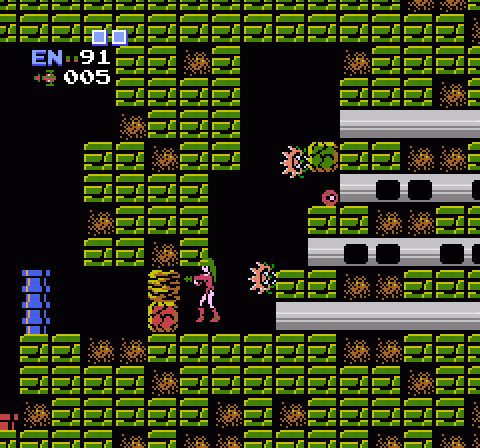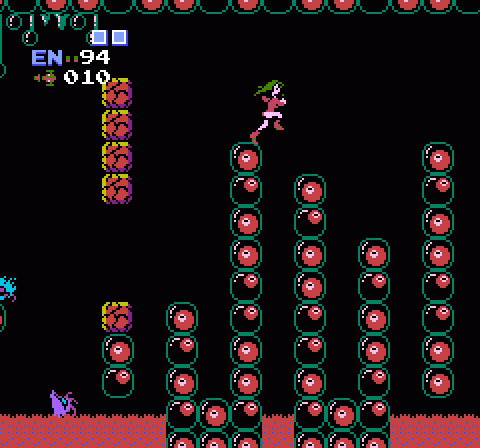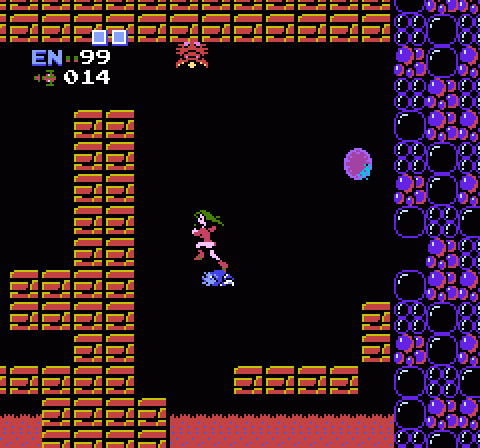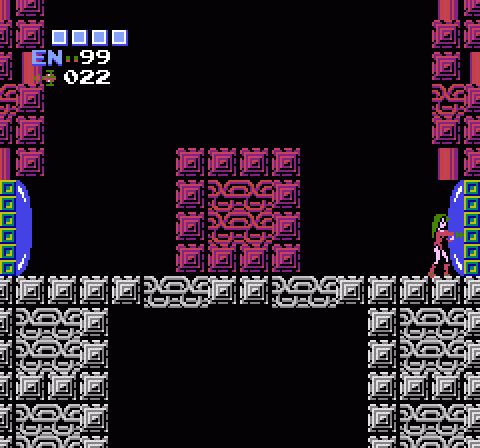As I mentioned yesterday, Metroid looks and plays like an action game, a superficial child of the arcades. But the core challenge of the game rests not in sheer combat difficulty, as it provides players with a huge arsenal, a considerable amount of life energy, and no (overt) timer to force you not to farm respawning foes for health. Once you have a few health expansions, there’s really no reason for you to ever see the game over screen short of a few tough combat sequences, a deliberate suicide to access the password screen and record progress, or a time-saving shortcut to shave minutes off your clock after reaching the depths of Ridley’s lair and wanting to jump back to the beginning of the game.
(In short: Suicide once and you’ll be returned to the entrance of Ridley’s hideout; go up the elevator and die and you’ll be at the start of Norfair; go up that elevator and die and you’ll return to your Brinstar spawn point at the beginning of the game. This is a very handy technique for making the best time possible for the best ending and is a unique property of Metroid‘s unusual continue system.)

No, the hard part of Metroid is simply getting to where you need to go. Or rather, figuring out where you need to go and most of all how to get there. If you simply play the game by its obvious rules, you’ll be able to see all of Brinstar, the span of Kraid’s lair, and a moderate portion of Norfair. Again, Kraid may be the more difficult miniboss to fight, but until you sort out the hidden secret of navigating Zebes, he’s the only one you can find.
Even without reading the manual, a lost player knows they’re missing something at this point in the game. You’ve found every power-up in Brinstar, cleared out Kraid’s lair (even getting that troll Energy Tank across the invisible gap in the floor, which might be the game’s single biggest dick move), beaten the first miniboss, and found an obscene number of Missiles. And yet… there’s still that one room at the top left of Brinstar’s super-shaft where a door appears across a pit of acid. You want to reach it, but you can’t. You shot the shimmering statue of Kraid and it rose slightly on some sort of piston, but there’s a second statue of some lizard-looking thing that remains inert. Clearly, you need to fight another boss, somewhere. But where?

Norfair seems the most likely candidate, because its available space for Samus to explore appears to be so much smaller than that of the other zones in the planet. Why should this one region be so much smaller than the rest? Yet everywhere you turn, it’s nothing but dead ends and weird environments that look to be made of melting fish eggs.
This is where Metroid stumbles a bit, and it’s a critical stumble. The key to advancing beyond this point — essentially, to unlocking an entire half of the game! — lies in an oddly counterintuitive action. You need to bomb your way forward, just as you did to unlock Kraid’s hideout. But where the game until now has telegraphed which blocks can be destroyed by making those blocks appear cracked and broken (with a very few exceptions, like the bridge over the first Ice Beam’s location), Norfair offers no such niceties. You need to intuit the fact that forward progress beyond here depends on finding bricks that can be destroyed even though they appear no different from the surrounding environment.
This is the old-school game design mentality at work: Hiding things with no clue whatsoever and leaving the player to tediously test every single possibility. You saw it in adventure games of this era (and beyond, really), in those isometric action-exploration games for Spectrum, in arcade games, and even in Metroid‘s Famicom Disk System cousin The Legend of Zelda. But whereas Zelda‘s most obscure secrets were almost entirely inessential (at least in the First Quest), here the need to bomb unremarkable walls gates the second half of the entire adventure.

In fairness, the game does offer a few small hints to the fact that most of Norfair is divided by unintuitive wall barriers that can be blasted through. The bomb-block passages can be either vertical or horizontal, and the horizontal ones tend to be right at Samus’ level. An errant shot just might reveal a surprising secret by blasting away one of the blocks a few spaces inside an otherwise unremarkable wall. If you’re lucky. And if you’re curious, you might explore what’s beyond. And you might string two and two together to come up with five and launch a bombing dragnet across the whole of Norfair.
Then again, you might have to rely on pure dumb luck to cause you to blow a hole in the floor elsewhere, like I did. After a month or two of being stymied by the game, I started goofing around and playing the game as much as possible in Maru-Mari form. (It was the only game I had for my new NES console besides Super Mario Bros., so I had to take my jollies where I could find them.) When I blasted an opening in a nondescript floor in Norfair, I was fairly stunned — but once I did so, it was just a matter of days before I finished the game.
But I know not everyone was so lucky when they played Metroid cold, and for them the latter portions of Metroid remained forever hidden away. Besides sheer blind luck and a lot of free time to smash your head against seemingly impermeable walls, the only way to deduce the path forward is through word of mouth or the help of a strategy guide, which stands as decidedly unfriendly game design.
Still, once you do figure out the shenanigans of Norfair’s hidden passages, the game opens wide. The bombable blocks appear in fairly specific configurations, too, so once you sort out the three or four likely patterns you don’t need to wander over every space dropping bombs. Even if you do, it’s a lot less painful than bomb exploration in Zelda since Samus’ bombs are limitless, can be dropped three at a time, and have a short explosion cycle. If you’ve been mapping the game, you can also make pretty good guesses about where to look based on what you have and haven’t found already. Once you get the hang of finding Norfair’s secrets, it becomes an interesting metagame between the player and the designers: What devious spot holds a fragile block in this room? (The part where they hid one beneath a pool of what turns out to be illusory magma is particularly nasty, in a clever sort of way.)
So the problem in Metroid isn’t so much the methodology with which its secrets are hidden but the sheer obscurity of the design. The game doesn’t offer any sort of substantial guidance at all to making this leap in deduction, and while there’s something to be said for designers leaving players to their own devices, the bomb passages in Norfair prove that it’s possible to be too hands-off. Thankfully, future Metroid games would handle this technique far more gracefully; even Fusion, for all its hand-holding, never overtly says, “Hey, bomb here!” — yet when the time comes to use that technique to advance, it unfolds in a fairly obvious and intuitive fashion. Chalk this up to more game design growing pains circa 1986; R&D1’s hearts were in the right place, but they didn’t quite hit the mark.

Amusingly, once you pass beyond Norfair and into Ridley’s lair, you won’t need the bomb technique to speak of. Ridley’s lair consists of solid blocks all the way through, and it’s remarkably straightforward in design. Almost an apology of sorts for the opaque hell of Norfair.
Norfair’s fish-egg blocks made me imagine a Metroid RTS in which those blocks are the cells of a planet-sized organism, and the player, controlling Samus, gets into the nervous system and takes control of this enormous being.
As for Ridley’s lair, the blocks are solid except for those fake blocks next to the energy tank, but at least that’s an honest, obvious trick.
I recognize that room in the second screenshot. If you fall between those columns Samus is about to fall between, you get stuck with no way out but burning to death. As innovative as Metroid putting the Zelda mentality to play in a platformer was, it had some cruel, cruel room designs in a few places.
I’ve always wondered about those columns. My assumption has always been, yeah, you’ll die. But I’ve never wanted to test it myself.